In the modern world, a properly functioning dehumidifier is vital in preserving a good indoor air environment because it removes unwanted moisture, thus preventing the possibility of dampness and mold formation. For the dehumidifier to work efficiently for a long duration, however, one must regularly clean the appliance. This guide outlines the basic steps to clean one’s dehumidifier effectively; these include regular maintenance and deep cleaning. With such instructions, a user is more likely to use the dehumidifier to its maximum, improve the air quality in the room, and prolong the life of the device. In addition, whether someone has never handled a dehumidifier before or wants to perfect his or her maintenance schedule, the article brings the process into small steps for the user’s convenience.
Why Regular Cleaning is Essential for Your Dehumidifier
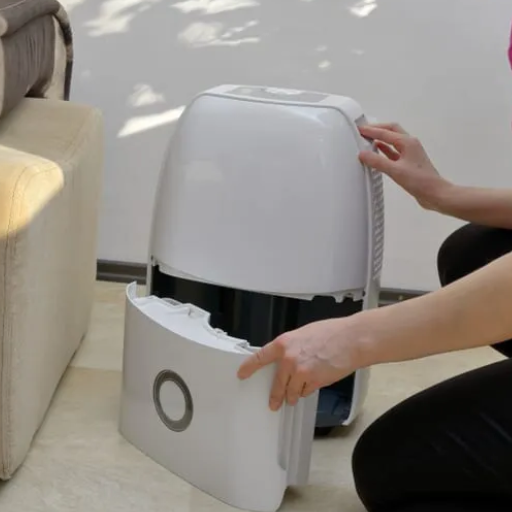
Always remember that proper cleaning is required for the dehumidifier to function effectively. Since the filters, coils, and even the water reservoir serve as the receiving end for dust, mold, and mineral deposits, their inability to function properly makes achieving air cleanliness difficult. Besides these, improper cleaning can also result in odors, bacteria, high energy usage, and even shortening the dehumidifier’s lifespan. Caring for the unit while alternately making sure it is used regularly helps avoid buildup, increase consistency of function, and improve air quality cleanliness.
The performance impact of dust and mold accumulation
An obstruction like dust and mold buildup tamper a dehumidifier’s performance by blocking air intakes, filters, and other essential components such as coils. Since airflow around the coils is hindered, their internal air responses become weaker, severely diminishing the dehumidifier’s removal potential. Blockages in airflow, for instance, result in a lower pints per day (PPD) moisture removal rating than the manufacturer has set forth. Blockages that impede airflow can send the extraction rate lower than a specified PPD. Moreover, as mold builds up, it can also get into the air that is being circulated back, which can alter the indoor air quality. In addition to reduced performance, the penalty of these obstructions is more energy and resources necessary (measured in kilowatt-hours) to operate the appliance. In this case, proper maintenance refers to ensuring that airways containing dust and mold are thoroughly cleansed. It greatly improves the thermal exchange efficiency of the coils, evaporator and condenser.
Importance of Cleaning Dehumidifiers for Air Quality Maintenance
A clean dehumidifier has a more positive influence on indoor air quality. Systematic servicing and maintenance procedures can achieve this. A dehumidifier’s operation depends upon several filters, which work in tandem to trap various airborne particles ranging from dust to pollen and even microbial spores. Filters, however, have to be clean and unclogged at the very most – otherwise, unwanted particles wreaks havoc on air quality. In terms of pollution, clean filters can neutralize up to 85% to 95% of airborne particles, but only when their MERV rating permits and granted that they remain unspoiled. Moreover, the internal coils and water reservoir must also be cleaned to eliminate mold and bacteria. Dehumidifiers regulate airflow and humidity with advanced components like RH control. With a clean device, the primary function of maintaining optimal indoor humidity between 30% and 50 % for comfort and health is done more efficiently. In terms of health benefits, well-maintained dehumidifiers provide even airflow throughout the coils and eliminate the humidity that can have microbial inside, so the building’s air quality improves significantly.
The Role of Routine Maintenance in Avoiding System Breakdowns
System breakdowns of a dehumidifier are usually preventable by ensuring that proper maintenance involves filters and coils being cleaned regularly. This ensures the airflow is maintained while humidity regulation is optimized, reducing the strain on the unit’s mechanical parts and increasing its lifespan. Also, it reduces and/or prevents microbial growth and moisture deterioration, usually associated with poor indoor air quality.
What Tools and Supplies Do You Need to Clean Your Dehumidifier?
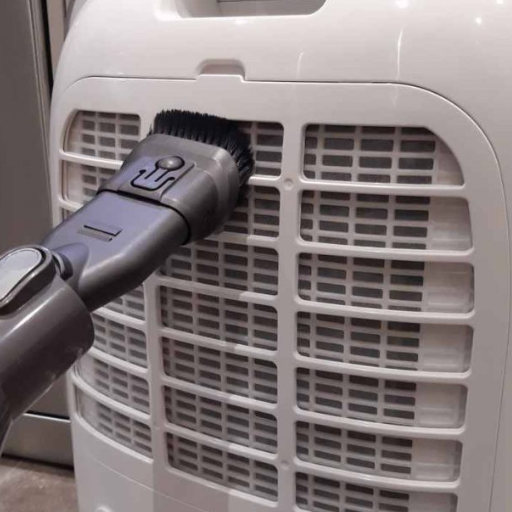
A few vital tools and supplies are required as a preparatory step to clean your dehumidifier. The list includes a soft sponge or a cloth for wiping, a vacuum cleaner with a brush to remove the dust from vents and a small hard brush or a toothbrush for cleaning remote areas. Moreover, cleaning water tank and other detachable pieces can be done using a gentle detergent or vinegar solution. Remember to have clean water for rinsing and a towel to dry the pieces after washing before reworking the unit.
Equipment to consider when cleaning the parts of the dehumidifier
- Soft Cloth or Sponge: Prevents dust build-up while cleaning; used on the dehumidifier’s exterior and large surfaces to avoid scratches on its surface.
- Vacuum Cleaner with Brush Attachment: This tool cleans dust from air vents and coils to ensure the proper functioning of the dehumidifier’s airflow and efficiency.
- Small Brush or Toothbrush: These are utilized to clean small components and otherwise difficult places, such as fan blades, dirt-prone intricate vent spaces, and other areas that are hard to reach.
- Mild Detergent or Vinegar Solution: This is used to sanitize the Water tank, removable filter, and the rest of the components. This gentle cleaning agent is used for germicide purposes to remove stains and residue and prevent odors and microbes from growing.
- Bucket Or Basin: These are used as containers for the spent water from the cleaning activity or for soaking the water tank and filter into the cleaning solution.
- Clean, Dry Towel: After being cleaned, the towel ensures that all components of the device are properly dried, avoiding moisture that can cause damage or fungus.
- Compressed Air Canister (Optional): Leveraging to blow fine dust from sensitive internal parts such as electrical panels and other components where moisture should be avoided.
Ingrediant in cleaning a dehumidifier and using them efficiently
When choosing cleaning agents for a dehumidifier, use diluted liquid non-ionic detergents that have a pH level of between 5 and 8, as these tend to be gentle on the components while ensuring effective cleaning. A combination of vinegar and water works effectively against odor and microbial particles. Hard scrubbing pads and abrasive chemicals should also be avoided as these tend to cause disintegration to the parts made from either plastic or metal. A chemical residue may be left behind if components are not rinsed which, in turn, gets exposed to further cleaning. Components should, therefore, be cleaned and rinsed thoroughly.
Use of proper equipment for proper safety standards
When cleaning a dehumidifier, always use protective devices such as gloves that minimize contact with mold, dust, or cleaning agents. Working goggles will also prove useful for the eyes when cleaning chemicals are sprayed. Cleaning a dehumidifier is effective when done in the open or in places with a high circulation of fresh air. Spraying protective wear also lessens the possibility of inhaling harmful particles and fumes.
How to Clean the Water Reservoir in Your Dehumidifier
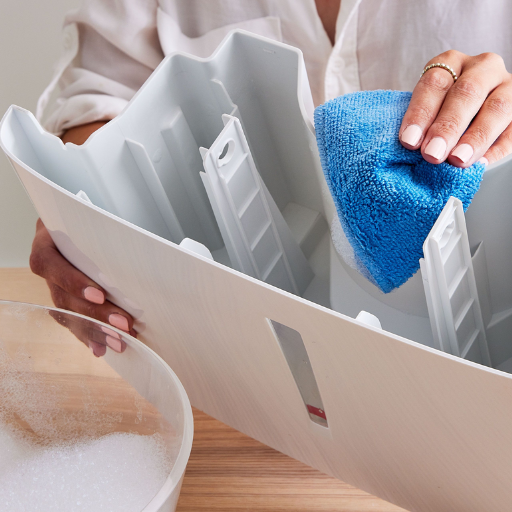
When cleaning your dehumidifier water tank, first disconnect the device from the power supply to prevent electric shock. Carefully detach the water tank and pour out any collected water. For routine cleaning, scrub both the inside and outside with warm, soapy water using a sponge or a soft cloth. For more advanced cleaning, add 1 part white vinegar to three parts of water and use the mixture to scrub the inside of the tank. This not only removes scale build up but also helps to prevent fungus growth. Once completed, wash the tank with clean water and place it somewhere warm to dry. Do not place the tank back in the dehumidifier until it is scorched.
Why it is Necessary to Get Rid of Residual Water in Order to Avoid the Unpleasant Smell
In the case of dehumidifiers, water leftovers in its container can result in bacteria, mold, and mildew, which can contribute to foul smells while also introducing health concerns. These organisms will have more activity when it is warm and humid because the water left stagnant will act as a breeding ground for them. The device’s malfunctioning may also occur due to odors that have not been removed in routine sanitary practices and the dehumidified space not having good air quality. Stagnant water can lead to microorganisms and bacteria growth that can lead to unpleasant smells. The even more worrying problem is that the build-up left over time can lead to scaling or mineral deposits, which can eventually shatter the reservoir. Using white vinegar or a light detergent can make sure that the build-up residue and bacteria are removed without damaging the container of the dehumidifier.
Instructions on How to Clean the Water Tank
- Before cleaning, turn the dehumidifier off by unplugging it first. This is for safety reasons.
- Remove the water container from the dehumidifier and pour any remaining water onto a sink or drain.
- Pour warm water into the tank and give it a good shake to remove unwanted particles and dirt.
- To create a cleaning solution, combine equal parts of vinegar and water or any mild disinfectant suggested by the manufacturer.
- Using a soft sponge or cloth, thoroughly cleanse the interior of the tank using the solution. Pay careful attention to any visible deposits, biofilms, or the corners of the tank.
- After rinsing the tank with water five times, confirm that all cleaning solution remnants have been eliminated.
- Position the tank in an open area for complete evaporation of water. Ensure this area is well ventilated and free from the humidifier.
- Inspect the tank often to check for wears or scales to ensure functionality is intact.
Ideas for hindering bacterial and mold reproduction within the reservoir
To prevent mold and bacteria from developing further in the reservoir, I first take to eliminate and clean the reservoir consistently to prevent water from becoming stagnant. I disinfect and clean the interior with white vinegar and water. After washing, I make sure that the tank is free from moisture. In addition, I make sure the dehumidifier and its surroundings are well ventilated to help reduce humidity and microbial generation.
How to Clean the Air Filters of Your Dehumidifier
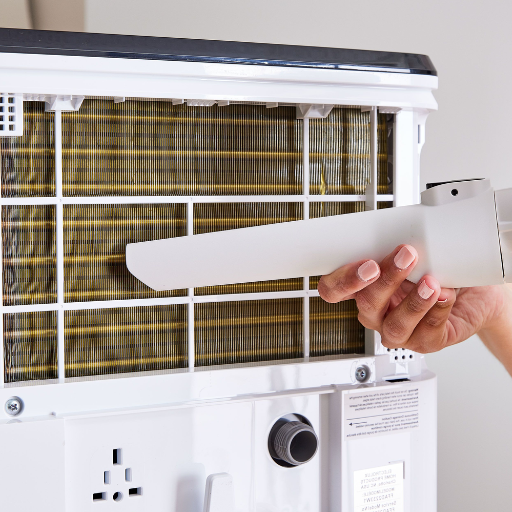
To ensure proper operation and air filtering, regularly wash your dehumidifier’s air filters. For everyone’s safety, begin by unplugging the device. Detach the air filter located at the back or side of the device. Be cautious not to drop any of the accumulated dirt and dust. If the filter is too dirty, towelette it with a soft soap when rinsing it with warm water. Don’t use any strong detergent or swirling brushes since they will ruin the filter’s material. After washing, place the filter somewhere with airflow but no sunlight so that it dries without bending. Now, put the filter back and turn on the dehumidifier. By routinely taking care of the filters, remember that it will help work more efficiently and last longer.
How to determine the filter used by your dehumidifier
As the first step in determining the type of filter for your dehumidifier, you will want to look at the user’s guide, which usually contains the filter particulars. Among the common filter types that dehumidifiers have are standard air filters and HEPA filters. Air filters are standard types of filters that remove bigger airborne contaminants like dust and lint, while their more advanced counterparts, HEPA (High-Efficiency Particulate Air) filters, focus on gathering smaller particles such as allergens and mold spores. HEPA filters can capture over 99.97% of particles with a size larger than 0.3 microns.
In addition, some dehumidifiers may have activated carbon filters for odors and some gaseous pollutants. Examine the filter for any labels or markings that may indicate the type of filter it is as well as its density and material composition. These facts are important for proper fitting when filters are changed out or upgraded, knowing that an equivalent standard of air cleanliness will be preserved.
How often should you clean or replace dehumidifier filters?
The manufacturer’s specifications and the type of filter determine the cleaning or replacement of dehumidifier filters. Most air filters are cleaned and changed within a one to three month period relative to other factors such as use and environment. High efficiency HEPA filters should be replaced every six to twelve months, but some types may be cleared and cleaned depending on the manufacturer. Carbon filters are exchanged every three to six months for optimal utilization in removing unwanted smells and pollutants. Proper maintenance guarantees the dehumidifier functions properly and indoor air remains pure.
Methods of improving clean filter efficiency through better airflow
In filters that I constantly clean such as a tank dehumidifier, I carefully check the filter meshes and remove any dirt by washing and soaking them in water. Once the dehumidifier is turned back on I ensure that all the cleaning processes are carried out to remove all excess water so it does not get stuck on the filter and creates mold. These filters are checked with a specific schedule so the airflow and overall performance does not drop. The area around the dehumidifier is also kept clean so the free airflow is not disturbed by any objects. All of these cleaner practices reaffirm the correct operational efficiency and energy use.
Cleaning the Coils and Fan: Key Areas to Maintain
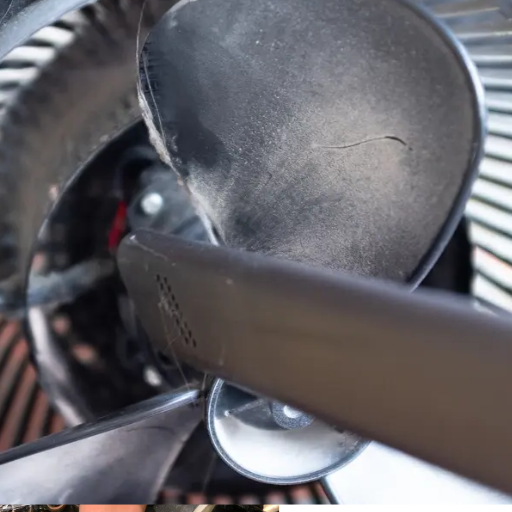
To keep a dehumidifier at its optimal operating parameters and ensure a longer service life, it is essential to service the coils and replace the fan at regular intervals. To maintain the effective heat exchange process, evaporator and condenser coils must be cleaned from dust, dirt, and buildups periodically. Based on the buildup, this may involve some scrubbing with a soft brush or using a vacuum or a coil cleaner. Additionally, the fan assembly and blades should be inspected to ensure cleaning is done to prevent airflow disturbance and noise from dust circulatory fans. Cleaning these parts helps minimize the device’s workload, aids in effective moisture extraction, and increases the survivability of the dehumidifier.
The contribution of coils and fans on dehumidifier efficacy
Coils and fans are among the core parts of a dehumidifier and they serve different yet collaborative purposes in removing moisture. The coils, which consist of the evaporator and condenser coils, cool and condense moisture from air. The evaporator coils cool the incoming air so that the water vapor present in it condenses into a liquid state, while the condenser coils aid in getting rid of the extracted heat. These proper activities of a dehumidifier unit heavily rely on adequate heat exchange and dust or debris accumulation can greatly impede this process, leading to lower efficiency and higher energy consumption.
Meanwhile, the fan, is responsible for airflow, pulling the humid air into the system and forcing the dehumidified air back into the space. Fan performance is directly linked to airflow measurement, commonly expressed in cubic feet per minute (CFM). A fan in poor condition might cause low airflow, and hence the system to fail to function correctly. Additionally, fan maintenance and cleaning to unblock airflow and periodic equipment check is required to prevent energy loss and ensure uninterrupted humidity control. The dehumidifier is only functional at maximum performance when both the components are in working unison.
How to Properly Clean and Service the Dehumidifier Coils
To clean and service the dehumidifier coils, you must take specific precautions to ensure maximum functionality and longevity of the unit. First, always unplug a dehumidifier from its power source. This way, you will not have to worry about the possibility of getting electrocuted. To access the coils, scratch off the casing from the outer part of the unit. If unsure, refer to the user manual that came with the unit. Brush and vacuum to remove any loose dust and other debris from the coils. If more cleaning is needed, a non-abrasive coil cleaner may be applied to a soft cloth and the coils can be wiped clean. Note that the coils should never be bent. After cleaning, the coils should be thoroughly dried before the unit is assembled. This type of maintenance should be performed every couple of months to ensure the dirt and dust do not build up and a proper heat exchange is still maintained so the dehumidifier continues to work correctly.
Cleaning the dust or dirt clogged fans
If dust particles are lodged within the fan of your dehumidifier, the first step is to switch off and unplug the unit. Use the user manual provided with the device to remove either the front or back panel that covers the fan. Thin layers of dust and dirt can be removed using a soft brush or, more effectively, a vacuum cleaner equipped with a brush attachment. For more arduous particles or dirt, dip a soft cloth in cold soapy water and wipe the blades without moving the fan. Ensure that the fabric is not dreshed to avoid messing with the fan’s alignment. After cleaning, allow the fan to fully dry before putting everything back together. Consistent cleaning of the fan ensures efficient airflow and avoids performance problems.
How to Safely Store Your Dehumidifier After Cleaning
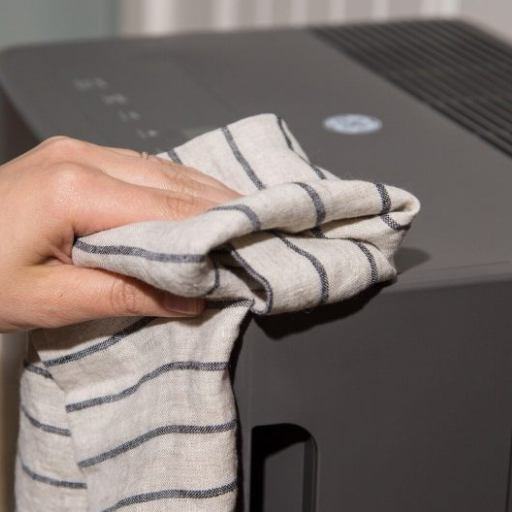
When storing the dehumidifier, place it in a region void of excess light and heat, which could impact the internal machinery. Also, ensure that the unit is free from any occult dirt while being educated on how to maintain it. After cleaning the unit, it is paramount that all parts are left to dry fully, as moistened components could foster mold or mildew, which can be problematic. Adhering to this procedure will support the dehumidifier’s structure and make it fit for use in the future.
Proper storage techniques to prevent damage during off-seasons
Prior to packing the dehumidifier for the duration of the off season, cautious measures must be put in place. For starters, try the best you can to detach the water tank, and rinse it clean to lift any dirt that is stuck in it. Place the tank in an area with good air circulation for the best results. First, examine the air filter and determine the most suitable cleaning method. Usually, it will include washing it under running water or vacuuming. Once it is clean, ensure it dries well before putting it back. Once reassembly is done, examine any internal parts of the unit for any remaining moisture. If some are found, leave the unit in a well-ventilated spot and remain for several hours.
To determine its optimal utilization, set the dehumidifier in a place with no extreme temperatures between the range of 40°F and 90°F. This ensures minimal risk to its motor and circuits. In combination with this, make sure to cover the device with a dust-resistant cover to allow it to breathe and so dirt accumulation is also minimized. Following the previously mentioned instructions will not only preserve the operational efficiency of the device but also extend its lifespan it.
Tips for maintaining your dehumidifier when not in use
- Ensure that any unwanted smells or bacterial growth does not occur by fully drying and emptying the water tank after the last use.
- The user manual air airflow and efficiency cleaning recommendations should also be followed when cleaning or changing the air filter.
- Make it a point to Store the device in a cool and dry place while upright, as this prevents damage to internal components.
- Once you are done with the device, ensure the power cord has no signs of wear or damage before putting it away.
- Finally, cover the device with a fabric that allows breathing while removing dirt and dust.
How to Store Your Dehumidifier To Avoid Dust Accumulation
A dehumidifier must be adequately cleaned to avoid dust accumulation while the unit is not in use. It is essential to clean the air filter, dry the water tank completely to ensure no moisture residue is left, and wipe the device’s exterior. Proper environmental storage is also necessary such as using a mesh or plastic cover to allow ventilation while protecting the device from dust. These steps ensure that the device remains clean and dry, with minimal chances of accumulating dust. Make sure to check the cover every once in a while to guarantee dust does not accumulate.
Reference sources
Frequently Asked Questions (FAQs)
Q: How often should I clean my dehumidifier?
A: It’s important to clean your dehumidifier regularly to maintain its efficiency. You should clean the filter and empty the dehumidifier bucket at least once a week. A deep clean of the entire unit should be performed every 3-4 months, or more frequently if you notice mold and mildew growing inside.
Q: What’s the first step to clean a dehumidifier?
A: The first and most crucial step is to unplug the dehumidifier to ensure safety. Never attempt to clean the dehumidifier while it’s still connected to power, as this could lead to electric shock or water damage.
Q: How do I clean the filter of my dehumidifier?
A: To clean the filter, remove it from the unit and gently vacuum it to remove dust and debris. If it’s washable, rinse it under warm water and mild soap. Allow the filter to dry completely before reinserting it into the dehumidifier.
Q: What’s the best way to clean the interior of the dehumidifier?
A: To clean the interior, first remove the bucket and clean it with warm water and mild soap. For the inside of the unit, use a damp cloth or sponge to clean the inside surfaces. You can use a mixture of warm water and white vinegar to help kill mold and eliminate odors. Avoid getting water on any electrical components.
Q: How do I clean the outside of my dehumidifier?
A: To clean the outside of your dehumidifier, use a damp cloth with mild soap to wipe down the exterior surfaces. Pay special attention to the air intake and exhaust vents, ensuring they’re free from dust and debris. Dry the unit thoroughly with a clean cloth.
Q: Should I use bleach to clean my dehumidifier?
A: While bleach can effectively kill mold, it’s generally not recommended for cleaning dehumidifiers as it can be harsh on the unit’s components. Instead, use a mixture of warm water and white vinegar or a specialized dehumidifier cleaning solution. If you must use bleach, dilute it heavily and ensure the unit is thoroughly rinsed and dried afterward.
Q: How can I clean the coils and fins of my dehumidifier?
A: To clean the coils and fins, use the hose attachment of your vacuum cleaner to gently remove dust and debris. For stubborn dirt, you can use a soft brush or a fin comb designed for air conditioners. Be careful not to bend or damage the fins, as this can affect the dehumidifier’s performance.
Q: In addition to cleaning, what else can I do to maintain my dehumidifier?
A: Regular maintenance is key to keeping your dehumidifier working efficiently. Empty the water tank daily, especially in humid conditions. Check and clean the air filter weekly. Ensure proper airflow around the unit by keeping it away from walls and furniture. Lastly, inspect the unit periodically for any signs of wear or damage, and address issues promptly to prevent further problems.



